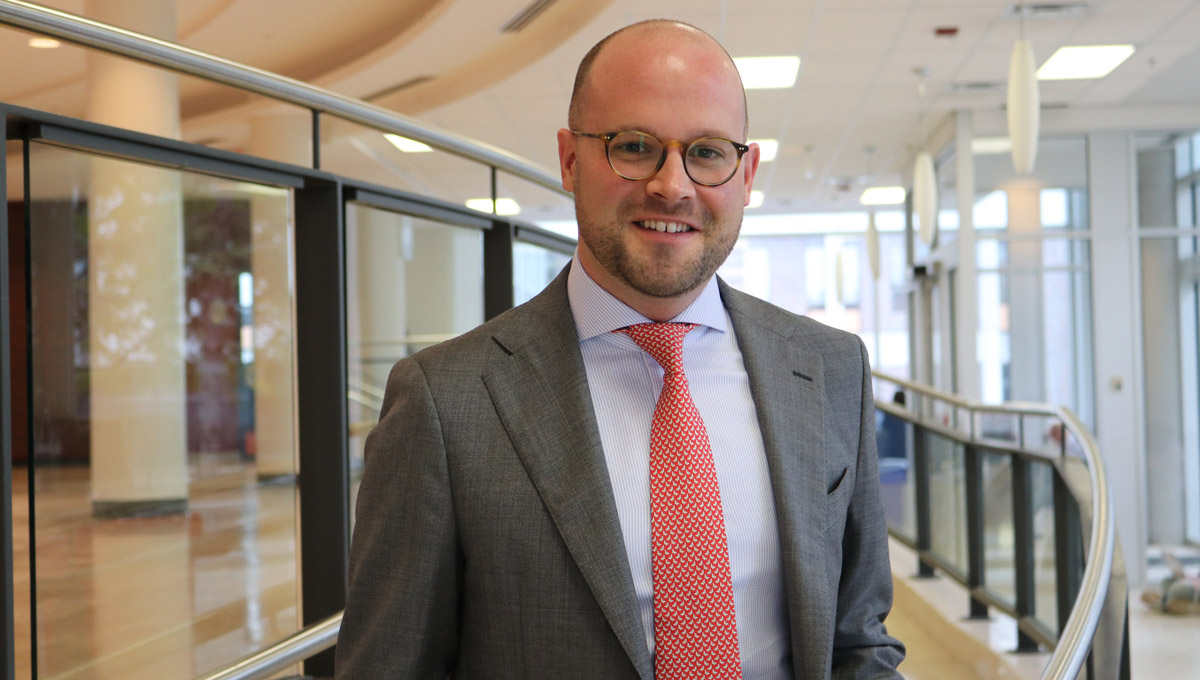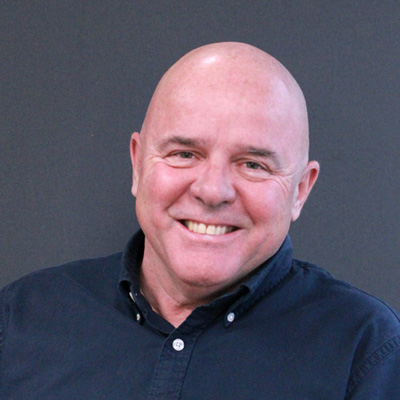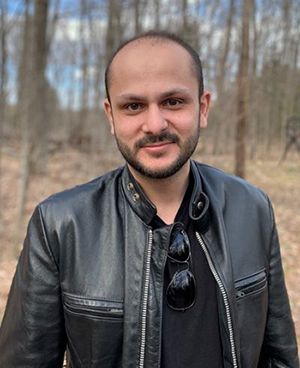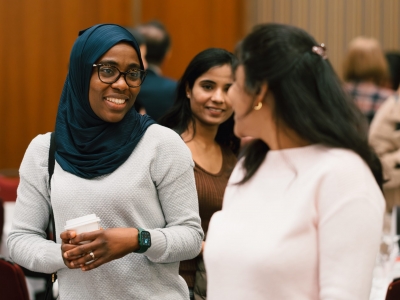By Tyrone Burke
“Good online learning is not just about getting on Zoom and holding a class live with people in boxes on the screen,” says David Hornsby, Carleton’s associate vice-president (Teaching and Learning).
“It’s about creating more flexibility for students, and using a range of educational tools to engage our students and help get them connect with course materials. Our office helps instructors find a whole range of pedagogical approaches that they can adopt. We have always done this. The difference in 2020 was a matter of scale.”

Associate Vice-President (Teaching and Learning) David J. Hornsby
The COVID-19 pandemic precipitated a rapid shift to online learning – even for courses that were never intended for online delivery. That shift won’t be permanent, but Teaching and Learning Services has been working overtime to ensure the university makes the most of this unusual academic year.
One way this has been happening is through the Students as Partners Program. More than 120 instructors have paired up with students to evaluate approaches to online learning this fall semester alone. Carleton’s is the largest program of its kind in Canada.
“It was important to find ways to connect students and faculty,” says Patrick Lyons, director of Teaching and Learning Services.
“This allowed faculty to benefit from student energy and technical know-how, and students to give direct, immediate feedback. Students drew on their experience to say what will work and what won’t. Carleton prides itself on having a student-centered learning experience, and the Students as Partners initiative is an excellent example of that.”
Teaching and Learning Services has also increased online learning workshops and doubled its staff to provide additional support. But the details of course design and delivery rest with the instructor, and Carleton instructors have been busy devising creative ways to deliver courses digitally.

Connecting Students with Biotechnology Innovators
“Almost everybody in the world is stuck in their house right now — or close to it,” says Martha Mullally, an instructor in the Department of Biology and co-ordinator of Carleton’s biotechnology program.
“That includes noted scientists who have written seminal papers. Several of my colleagues came up with the idea to have some of those people do Skype or Zoom sessions where students interact directly with the author of a paper.
“We imagine that in order for somebody to come to your class, they need to come in person. But in this case, you know that colleagues in England or Australia are also at home at their desks. So we can reach out and say that students are really interested in their work and offer a chance to speak with them.”

Instructor Martha Mullally
For her biotechnology courses, Mullally will be arranging video sessions with biotechnology business people.
“Typically, I have Ottawa biotechnology entrepreneurs come to the class and give a talk. This year, I’ll be having them Zoom in for a meeting, and students will still have a chance to interact with them.”
It’s one of the ways that Mullally is seeking to re-create the collegiality of the study of science in a physically distanced world.
“Students build their own technology companies in these courses, and that requires that they interact with each other,” she says.
“I’ve been using a new software called Visual Classrooms that was designed by a group at the Tufts University Medical School in Boston. It facilitates collaborative, online learning in real time. I’m really excited about this and a little bit terrified too, but I’m sure it’s going to be great.”

Examining Religious Freedom in the Age of COVID-19
“We are going to start this course by saying: ‘First of all, welcome to this moment. It’s crazy. It’s uncertain. And we’re going to make the best of it,’” says Melanie Adrian, an associate professor in the Department of Law and Legal Studies and Carleton’s Chair of Teaching Innovation.
Through a Shared Online Projects Initiatives (SOPI) grant, Adrian has teamed up with the University of Ottawa’s Lori Beaman to develop an online version of the course “Is Religious Freedom a Human Right?” It deals with potentially contentious topics like faith, religion and human rights, and Adrian always envisioned it as a classroom-based course. But the pandemic pushed it online this year and she’s using digital tools to make the most of this new teaching environment.

Chair of Teaching Innovation Prof. Melanie Adrian
LAWS 4903 even has its own Hollywood-style trailer on YouTube.
“The mission of the university is all about broadening horizons,” says Adrian. “My personal goal is to recreate that ‘ah-ha!’ moment that we can create in classrooms, where the complexity and the nuance of ideas can be discussed collectively imagined.”
Adrian built flexibility into the course design to accommodate different learning styles.
“I thought of each week as a module, with seven hours in total. In a typical fourth-year class, we have three hours in class and four hours of preparation time,” she says.
“But, of course, we won’t have three hours in class. So I asked myself what we could do in seven hours that would provide substantive content to the ideas for the week, and how to do that in an online format that is accessible and not too weighty. There will be different modalities of reception and learning. I have a podcast, a video component and readings for every week. Students can choose to watch, stream or download them, depending on their Internet connection.”
As for course content, it’s rooted firmly in the current moment. Course materials speak to contemporary issues in religious freedom around the world, and they will tackle religion and the pandemic head-on.
“Our first week will be on COVID-19. A lot of religious communities have had to change the way they practice,” says Adrian.
“In Canada, we had a controversy around the Islamic call to prayer. In the United States, there were controversies around assembly — some mega-churches that were still meeting, and there were a number of lawsuits about this as well. We will talk about these issues. Not only do they affect us personally, they also affect us theoretically.”

E-internships Allow Students to Gain Job Experience
International internships help students gain work experience and beef up their resumes, but they create some problems too. The emissions from international travel have a significant environmental impact, and they can strain the resources of host organizations.
“Carleton has been sending students overseas since the 1950s, but many authors from the global south tell us that those kinds of learning opportunities are great for students, but not so great for community partners,” says Marylynn Steckley, an instructor in Bachelor of Global and International Studies in the Faculty of Public Affairs.
In 2017, Steckley began working with her students on e-internships. Students working on the Carleton campus have contributed to international development projects, including food security advocacy in Peru and women’s rights in several African countries.
In one global and international group project, students will be working with the National Newcomer Navigation Network – N4 for short — a platform of service providers for newcomers to Canada. N4 streamlines information about newcomer services to ensure no one is left behind.
“Students will be working on some really cool projects,” Steckley says.
“They’ll be interviewing newcomers to Canada about their service provision experience. They will create infographics, write blog posts and design websites. There’s a wide array of job of internships for students this year.”
The initiative predates the pandemic, but with physical distancing built in from the beginning, it is tailor-made for delivery during COVID times. Working from a distance also makes internships more accessible to students with fewer financial resources.
“A lot of overseas internships demand that students have pretty deep pocketbooks — or at least (that) their parents do,” says Steckley.
“For just the cost of tuition, this course gives students a meaningful work opportunity.”

Design Students Work with First Nations Communities
Many of Canada’s corporate leaders have never visited a First Nations community. And many First Nations leaders have never worked for a large corporation.
“We found that neither side understood the other’s context — the constraints, the challenges, or the demands on their time,” says Rick Colbourne, the assistant dean of Equity and Inclusive Communities at Carleton’s Sprott School of Business.
To bridge the gap, Colbourne created the Industry Council for Aboriginal Businesses Leadership Exchange, which brought together executives from corporations and First Nations communities. Corporate partners spent three days in the First Nations community, and First Nations community leaders spent three days within the corporate community. (Check out a documentary on the program here)
“It helps them understand the issues and challenges, and also the processes that people face,” says Colbourne.
But it isn’t only corporate executives who have a knowledge deficit about life in First Nations communities. Many non-indigenous Canadians haven’t visited First Nations communities, and that lack of familiarity can make it difficult to understand a community’s actual needs.

Sprott School of Business Assistant Dean of Equity and Inclusive Communities Rick Colbourne
“Because we’re dealing with COVID, we can no longer get into the communities. So, we’re using a virtual reality (VR) platform to create a 3D environment that will enable students and community members to engage with each other,” says Colbourne.
“The Distributed Studio project will create an immersive space where community members and our industrial design students will be able to collaborate, and interact with products or services in real time. It’s immersive, so they can engage, and get feedback and engagement.
It’s bringing together researchers from the Sprott School of Business, the Canadian Health Adaptations, Innovations & Mobilizations (CHAIM) Centre, the Department of Systems and Computer Engineering, and the School of Industrial Design.
Once the new VR platform is operational, it will take design students inside of housing and other community buildings. This can help build understanding of a community’s context, and design products that are responsive to its needs.
It will also be a tool that First Nations and Inuit communities can use to share knowledge with each other.
“Community members will be able use it to stay in touch, and to learn traditional teachings,” says Colbourne.
“Not all community members have access to that anymore. It could help teach language, or the geography that the community engages with. There are many ways that this could play out. The idea is to create a tool that is responsive to the needs of the community, and to have the community lead, right from the get-go.”

Digital Tools Help with Complex Coding Problems
“I will be talking with students twice a week on Zoom, but it won’t be a lecture,” says Paulo Garcia, an assistant professor in the Department of Systems and Computer Engineering.
“I’ll be giving a 10-minute big picture overview that connects the dots and makes sense of the course materials and lab questions. Then I’ll be taking questions and doing demonstrations.”

Prof. Paulo Garcia
Even before the pandemic, computer engineers were learning largely from screens, so many online tools are well-suited to teaching in the discipline. Shared screen functions will give students an up-close look at demos, as apps like Zoom offer them the opportunity to record complicated, multi-step coding sequences and work through these processes later at their own pace.
“I’m planning for a very asynchronous style of learning,” says Garcia.
“Here are the resources that students need, what they should read, and what they should do. But there is no fixed time to do it, only deadlines; they can do it when it’s convenient for them.”
Students will be working with an operating system that Garcia designed himself.
“I give them all the permissions that they want and reset the repository at the end of each term,” says Garcia.
“Students can branch out and add features to the system. I can look at them, try them out, see if these features make sense. I can add them to the repository for every student to see, or provide feedback about something that they forgot. And I can correct their code, not in real time, but almost.”
Monday, August 31, 2020 in Teaching and Learning
Share: Twitter, Facebook



